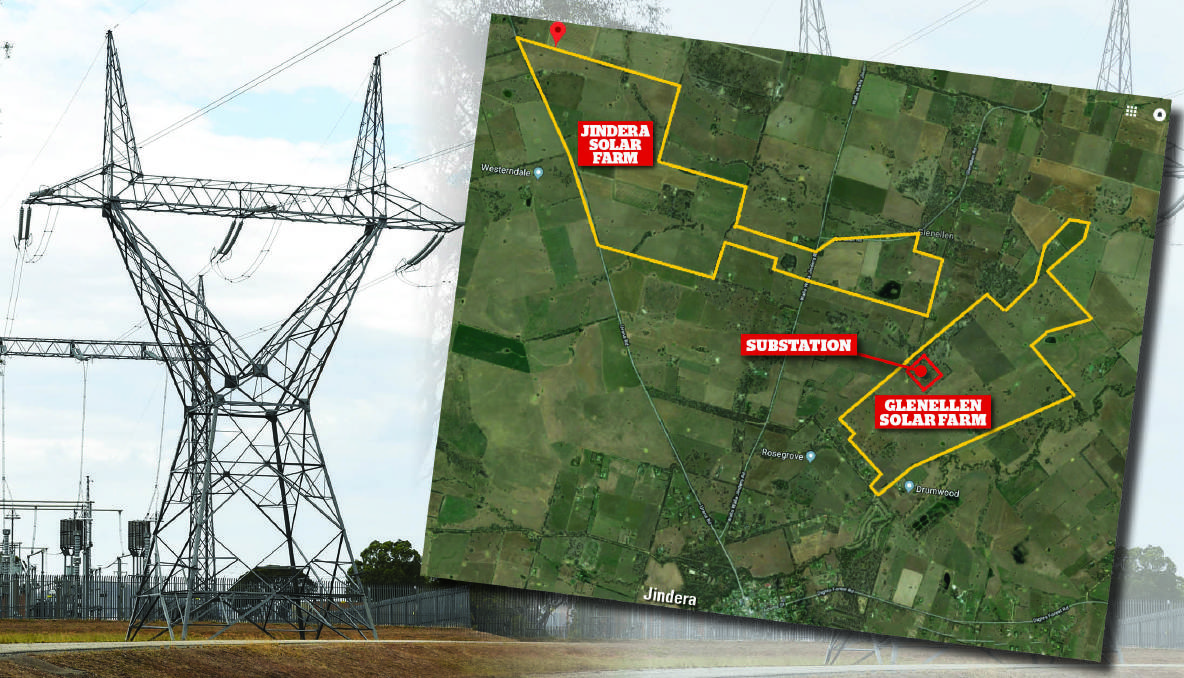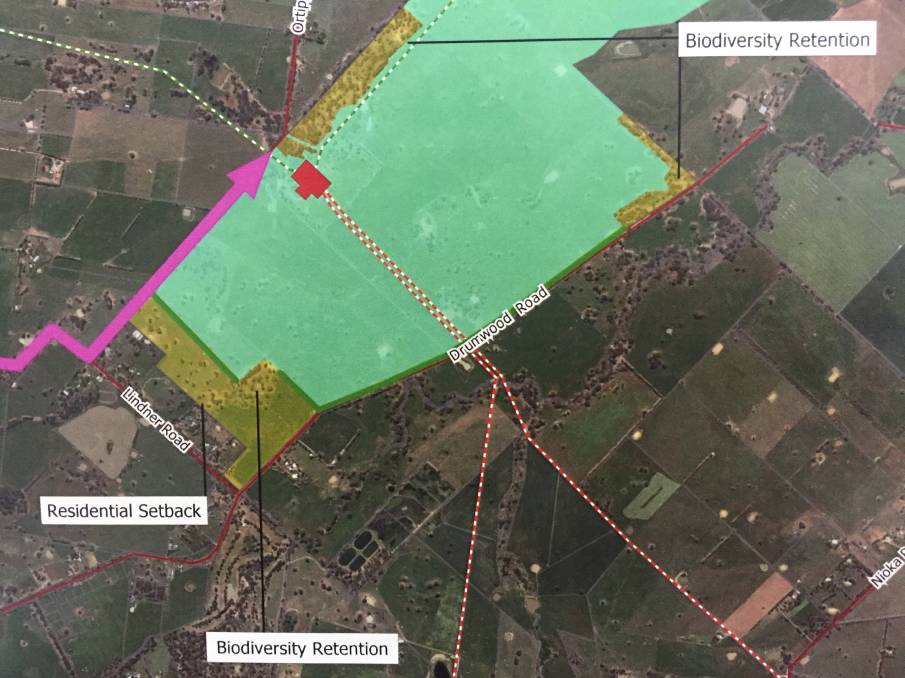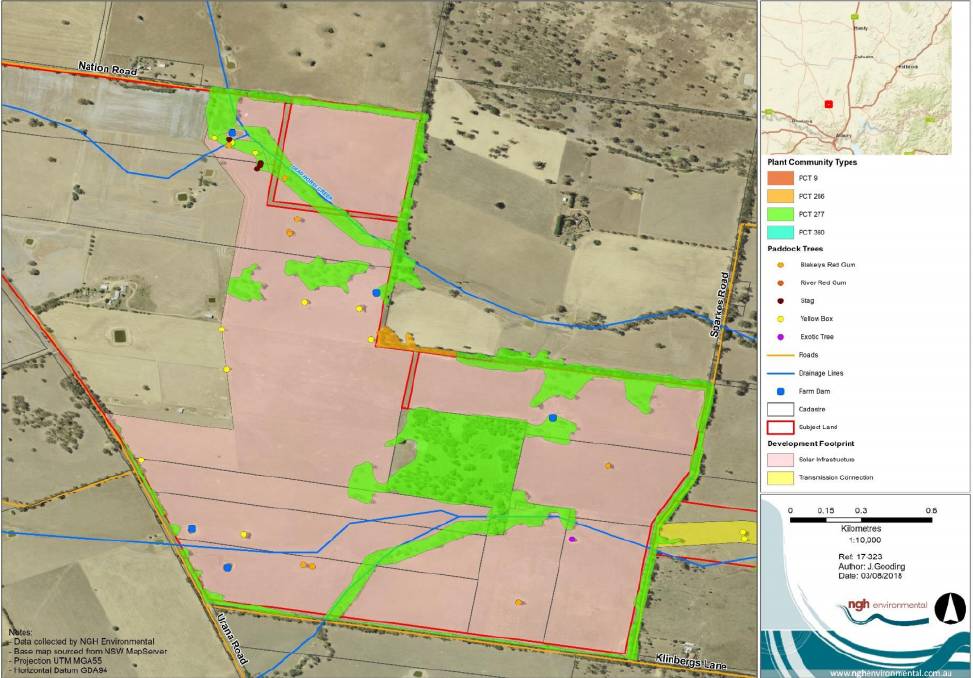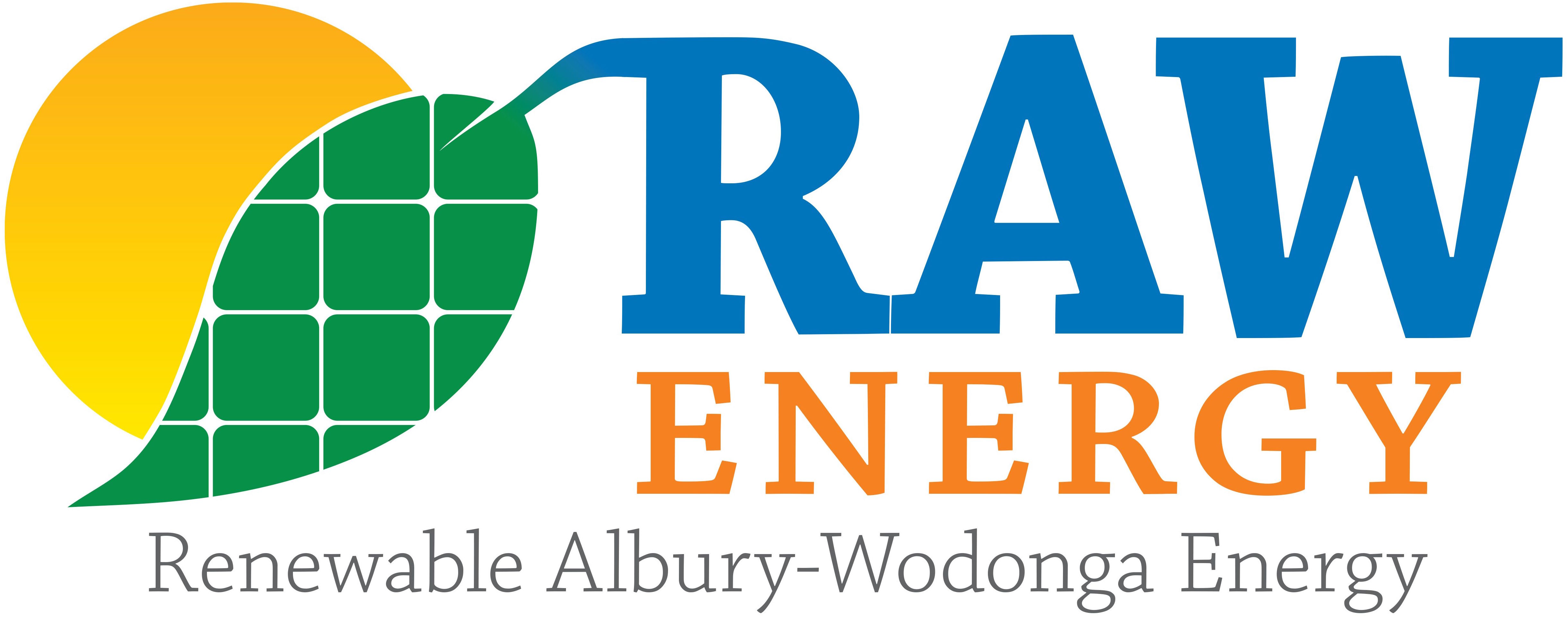
Environmental impact statements for Glenellen and Jindera solar farm proposals being finalised
PROPOSED: There are plans for two solar farms near Jindera. Above are the project land areas as outlined in preliminary plans put to the NSW government. Panels would not cover the entirety of the properties, which would be leased for 20-30 years.
Environmental impact statements are being finalised for proposed solar projects worth a combined $300 million near Jindera, which could cover more than 700 hectares if approved.
CWP Renewables, and Hanwha Energy working in partnership with Green Switch Australia, began talking with residents and the state government midway through last year.
CWP is planning a 200 megawatt (MW) project called the “Glenellen solar farm” about four kilometres from the township, which would be bordered by Drumwood and Ortlipp roads.
The joint 130MW “Jindera solar farm”would spread across two sites connected by a planned transmission line running between Walla-Walla-Jindera and Sparkes roads.
While the projects are independent of each other, both are proposed to connect to the Jindera Transgrid substation, and could only be one kilometre apart in that area.
The companies, which have projects in Australia and overseas, are two steps through a seven-part approval process overseen by the NSW planning department.
Jindera Solar Farm project director Symon Grasby said it was hoped the environmental impact statement, which looks at the suitability of the site and how it would affect the biodiversity of the area, would be lodged in coming months.
“The site has good characteristics; our modelling shows there is a good level of solar radiation, and because of the large substation at Jindera we can get a connection which allows the power that’s generated to reach the grid,” he said.
“We’ll do the best job we can in our application and will respond to any queries that come out of that process.
“We’ve had a number of questions put to us about the use of agricultural farm land for solar farming and whether or not that is a good thing – obviously we would say it’s a good thing.
Fast facts
“We understand and respect that other members of the community have a different view on that.”
A working group of about seven Jindera residents have come together to represent those in the community opposed to the two projects.
Jim Parrett, whose Drumwood Road property faces the CWP Renewables site, said important agricultural land should not be locked away for the next 30 years.
“I’m not against renewable energy and I’ve worked on renewable energy projects in the past – but they were in locations that suited it, and this isn’t one of those locations,” he said.
“Jindera is one of the fastest-growing rural-residential areas and these plans do not take into account the big picture of how the area will change.
“Between the sites there would be roughly 200 mature trees removed, which then causes a groundwater problem and a dry-land salinity problem, when we already have enough problems with flooding.
“The other problem I have is this turns neighbour against neighbour and divides communities.
“You’re proposing something that’s going to change livelihoods and drop land value – who wants to buy my place now that there will be 1600 acres of solar panels from our boundary?”
Murray Bartley, who lives at the southern end of the CWP Glenellen proposal, was also concerned.

CONCERNS: Plans for the CWP Renewables "Glenellen Solar Farm" as at December last year. Murray Bartley's property is on Lindner Road and despite the proposed setback he is concerned about visual impact.
“We’ve been out here for 15 years and saw this beautiful rural land – there’s a swamp with all native birds – and were told it would never be subdivided,” he said.
“I can’t imagine it all being blanketed by solar panels.
“They have told me there will be a set-back and trees planted as a screen, but the trees in my property that have been growing for 15 years don’t block the view.
“What will be the impact on radiant heat? I’ve read that it could be up to four degrees higher.”
CWP Renewables chief operating officer Ed Mounsey said feedback regarding visual and environmental impacts had been taken into account and other issues would be addressed in the environmental impact statement, to be lodged within months.
“Then there’s the social considerations which is part of the community engagement process, and that’s been front and centre since mid last year in terms of getting out into the community, providing information around the proposed project and receiving feedback and making amendments,” he said.
“We’ve introduced setback distances from property boundaries.
“We will provide environmental offsets and set aside some areas for conservation.”
This turns neighbour against neighbour and divides communities ... you’re proposing something that’s going to change livelihoods
Jim Parrett of the Jindera solar plant working group
Native woodland such as Blakley’s red gum, classed as a threatened ecological community, is present on land in both project areas, but CWP outlined in their preliminary assessment “very little woodland would be subject to clearing”.
Mr Grasby said where possible, vegetation would be retained in relation to the project as well.
“Unfortunately it is the case that with solar farms some vegetation may be removed subject to necessary consent, in order to create a better layout for the solar farm,” he said.
The land for both sites is zoned RU1 primary production and is used for grazing, with about half of the soil in each project area being class three, categorizing it as “high capability land – that has moderate limitations and is capable of sustaining high-impact land uses”.

An example of the vegetation classes on part of the Jindera solar farm proposed site (PDF proposal)
The remaining soil is classed low capability.
In public discussions about potential projects at Culcairn, farmers have raised concerns about land mapping for the Greater Hume Shire.
They have argued that while certain areas are not classed as “important agricultural land”, they still have the ability to cultivate crops and should be protected from development.
Important agricultural land is listed as an “area of constraint” in new guidelines for state significant solar development (those that are worth more than $30 million) released last month, but is not exempt from solar development.
Seven key site constraints were outlined which “do not preclude large-scale solar energy development on certain land, but indicate issues which may exist”.
The presence of threatened ecological communities and soil capability classes of 1, 2 or 3 are considered constraints, and both criteria apply to the two Jindera projects.
The cumulative impact of the proposed solar developments must also be taken into account, the document advises.
But, “sites with multiple environmental and planning constraints may still be capable of being developed in a sustainable manner”.
Mr Parrett said the guideline was “soft”.
“From what we’ve heard it doesn’t matter what evidence you have – these plants get approved,” he said.
“One of the issues we have here in NSW is the local council is not the consent authority, like it is in Victoria.
“The Glenrowan project was knocked back on visual impact as it was within 3km of town – this one is within four or five of Jindera.”
Mr Parrett said there were less productive areas of land in the state that would better suit solar panels – and that the government should be spending the money to enable such areas to connect to the grid.
“The developers have openly told us they chose this area because of the substation – there’s no loss in transmission,” he said.
In the two Jindera applications being determined by the consent authority – which is the Planning Minister, unless there are more than 25 objections and it goes to an Independent Planning Commission – public interest will also be considered.
Jindera Solar Farm project director Symon Grasby said there was a “clear movement” towards solar that needed to be facilitated through large scale projects like the ones in Jindera.
“We are undertaking this project because Australia, like many countries, is trying to transition from fossil fuels as a source of electricity generation to renewables,” he said.
Jindera residents will be able to make submissions to the projects when applications are put out for public exhibition for a month.
